|
HOME: www.hiltonpond.org |
|||
THIS WEEK at HILTON POND (Back to Preceding Week; on to Next Week) |
HERO TO AMERICA, AND THE WORLD: NOTE: I hope visitors to this Web site will indulge me a moment and allow a personal note about someone who had a profound effect upon me as an educator and a scientist. I also hope no one will be disappointed a shorter version of the following photo essay was published on this Web site in 2003 when Space Shuttle Columbia failed. I was deeply saddened by that event and more so--for personal reasons--by this week's passing of Neil Armstrong, the quintessential astronaut and science-oriented engineer. BILL HILTON JR. PREFACE to 2003 INSTALLMENT: As an educator-naturalist, I investigate flora and fauna around me on Planet Earth, but I have utmost respect for those who reach for the stars and explore the cosmos. As a tribute to these explorers and as an expression of my sadness over the latest shuttle disaster, I've opted to post the following article I wrote for The York Observer in Rock Hill SC in 1989 on the 20th anniversary of the Apollo 11 lunar expedition. It's a bit different from our usual nature essay from Hilton Pond Center, but I think you'll see the connection . . . . All text & photos © Hilton Pond Center ADDENDUM for 2012: All text & photos © Hilton Pond Center 20-YEAR MEMORIES OF A BARTOW, WV--Today, 20 July 1989, is a special day in the history of the U.S. space program, and people around the world are recollecting where they were exactly 20 years ago in 1969 when Neil Armstrong made his first small step onto the surface of the Moon. I, too, have been thinking about that event, but my own memories of Armstrong go back five more years to 1964. That summer I was privileged to be among 100 high school scientists from around the country--two from each state--picked by their governors to attend the National Youth Science Camp at Bartow, West Virginia. The NYSC was begun in 1963 to celebrate West Virginia's Centennial; in the years since plenty of top-notch, big-name scientists have visited the Mountain State to speak to NYSC delegates. None, however, had as much an impact on me as did the future astronaut who lectured during my camper year.
All text & photos © Hilton Pond Center In July 1964 Neil Armstrong enthralled me and my fellow delegates with his presentation about futuristic plans for the Apollo manned mission to Earth's Moon. I distinctly remember him standing before us outside the camp's rustic lecture hall, precise in his delivery and majestic in his professionalism and military bearing. When I close my eyes I can still trace an image he drew on the chalkboard (above)--a simple line drawing showing how the Apollo 11 module would need to fly a figure eight around Earth and Moon for a successful landing and eventual return trip. There Armstrong was--still five years away from his ever-famous Moonwalk--already explaining and studying and practicing the moves he would execute to bring his lunar lander down at Tranquility Base. Talk about advance planning!
All text & photos © Hilton Pond Center That evening aeronautical engineer Armstrong--despite appearing formal in a dress suit and tie (but no white socks or pocket protector!)--gathered at the campfire circle for an informal question and answer session with what I'll admit is a geeky-looking bunch of delegates (above). I'm relieved and pleased to say none of us just-graduated high school honor students--many wearing our coveted blue blazers with the radio telescope emblem--posed the query astronauts almost always get from younger audiences: "But how do you go to the bathroom in space?"
Next morning everyone was still talking excitedly about the astronauts' telegram as we saw the campers to Charleston's airport for flights home. Staff then returned to Bartow to break camp and on 16 July at 9:32 a.m. gathered around the only available television set at a small rural motel several miles away. We cheered and clapped at the successful liftoff (above left) of the giant Saturn rocket that propelled Apollo 11 out of Earth's atmosphere, and after that it was just a matter of waiting for Neil Armstrong and his colleagues to make their three-day trip to the Moon. Shortly after the successful rocket launch we closed camp for the season and I made a trip of my own back home to Rock Hill SC. A few evenings later on 20 July I joined my parents and siblings in the TV room to watch Armstrong exit the lunar lander (below right). Last week I returned to Bartow to celebrate my 25th anniversary as an NYSC delegate and to deliver my own lecture to the 1989 National Youth Science Camp. With cold chills crawling up and down my spine, I tried to convey to the current crop of campers how exciting it had been to meet Neil Armstrong 25 years earlier and to talk with him about his plans to be the first man on the Moon. I was nearly speechless at using the very same chalkboard my favorite astronaut had used back in 1964. 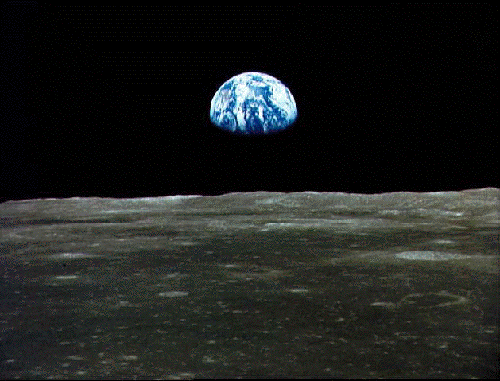
Near the end of my talk, I wished the science campers success in their upcoming college careers, and then I showed them an Earthrise photograph Armstrong's crew had taken from the Moon. My point was that Neil Armstrong and all the other astronauts and cosmonauts have a unique perspective that none of the rest of us can really know. They have seen the "little blue marble" called Earth hanging in the immense black void of space. From a quarter million miles away they have scanned our wispy clouds and our oceans and the continents of terra firma we walk upon each day. They understand, as can no others, how small a planet we inhabit, how delicate Spaceship Earth really is. I closed my lecture with another wish: That every 1989 science camper--and every Earthling, for that matter--could do as astronaut Neil Armstrong did and view our tiny planet from afar.
"For those who may ask what they can do to honor Neil, All text & photos © Hilton Pond Center POSTSCRIPT for 2012: We need many more heroes like Neil Armstrong who can lead by example without divisiveness or ego, who spend less time defending their turf than expanding the reach of the human species. Farewell, Commander Armstrong. Those 1964 Science Campers will never forget you or your accomplishments. We'll ever remember you showed the world how grand science and technology can be when one allows facts and numbers and open-mindedness to triumph--and to override the frightening epidemic of anti-science and hubris and political turmoil that drags us down today. In the words of a national newspaper columnist, "We have traded the inspirational for the ideological"; alas, we are hurtling not toward the stars like Neil Armstrong and his kind but down a path of selfish mediocrity that serves no one well. All text & photos © Hilton Pond Center
Checks also can be sent to Hilton Pond Center at: All contributions are tax-deductible on your |
|---|
 The Piedmont Naturalist, Volume 1 (1986)--long out-of-print--has been re-published by author Bill Hilton Jr. as an e-Book downloadable to read on your iPad, iPhone, Nook, Kindle, or desktop computer. Click on the image at left for information about ordering. All proceeds benefit education, research, and conservation work of Hilton Pond Center for Piedmont Natural History. The Piedmont Naturalist, Volume 1 (1986)--long out-of-print--has been re-published by author Bill Hilton Jr. as an e-Book downloadable to read on your iPad, iPhone, Nook, Kindle, or desktop computer. Click on the image at left for information about ordering. All proceeds benefit education, research, and conservation work of Hilton Pond Center for Piedmont Natural History. |
|
|
"This Week at Hilton Pond" is written and photographed by Bill Hilton Jr., executive director of Hilton Pond Center for Piedmont Natural History
|
|
|
Please refer "This Week at Hilton Pond" to others by clicking on this button: |
Comments or questions about this week's installment? Send an E-mail to INFO. (Be sure to scroll down for a tally of birds banded/recaptured during the period, plus other nature notes.) |

Click on image at right for live Web cam of Hilton Pond,
plus daily weather summary
Transmission of weather data from Hilton Pond Center via WeatherSnoop for Mac.
|
--SEARCH OUR SITE-- For a free on-line subscription to "This Week at Hilton Pond," send us an |
|
Thanks to the following fine folks for recent gifts in support of Hilton Pond Center for Piedmont Natural History and/or Operation RubyThroat: The Hummingbird Project. Your tax-deductible contributions allow us to continue writing, photographing, and sharing "This Week at Hilton Pond" with students, teachers, and the general public. Please see Support or look below if you'd like to make a gift of your own.
|
If you enjoy "This Week at Hilton Pond," please help support Hilton Pond Center for Piedmont Natural History. It's painless, and YOU can make a difference! (Just CLICK on a logo below or send a check if you like; see Support for address.) |
|
Make credit card donations on-line via Network for Good: |
|
Use your PayPal account to make direct donations: |
|
If you like shopping on-line please become a member of iGive, through which 950+ on-line stores from Amazon to Lands' End and even iTunes donate a percentage of your purchase price to support Hilton Pond Center.  Every new member who registers with iGive and makes a purchase through them earns an ADDITIONAL $5 for the Center. You can even do Web searches through iGive and earn a penny per search--sometimes TWO--for the cause! Please enroll by going to the iGive Web site. It's a painless, important way for YOU to support our on-going work in conservation, education, and research. Add the iGive Toolbar to your browser and register Operation RubyThroat as your preferred charity to make it even easier to help Hilton Pond Center when you shop. Every new member who registers with iGive and makes a purchase through them earns an ADDITIONAL $5 for the Center. You can even do Web searches through iGive and earn a penny per search--sometimes TWO--for the cause! Please enroll by going to the iGive Web site. It's a painless, important way for YOU to support our on-going work in conservation, education, and research. Add the iGive Toolbar to your browser and register Operation RubyThroat as your preferred charity to make it even easier to help Hilton Pond Center when you shop. |
|
BIRDS BANDED THIS WEEK at HILTON POND CENTER 1-25 August 2012 |
|
|
SPECIES BANDED THIS WEEK: * = New species for 2012 WEEKLY BANDING TOTAL: 4 species 113 individuals 2012 BANDING TOTAL: 31-YEAR BANDING GRAND TOTAL: (since 28 June 1982, during which time 171 species have been observed on or over the property) 126 species (31-yr avg = 66.5) 57,794 individuals (31-yr avg = 1,865) NOTABLE RECAPTURES THIS WEEK: All text & photos © Hilton Pond Center |
OTHER NATURE NOTES: All text & photos © Hilton Pond Center |


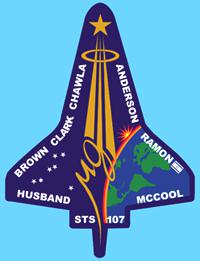 Like millions of people in the U.S. and around the world, I spent the next several hours glued to television, absorbing the day's events and mourning the loss of seven Israeli and American astronauts who died in the pursuit of scientific research.
Like millions of people in the U.S. and around the world, I spent the next several hours glued to television, absorbing the day's events and mourning the loss of seven Israeli and American astronauts who died in the pursuit of scientific research.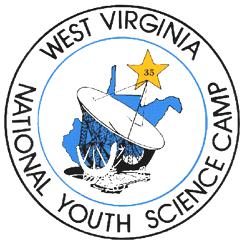 At the NYSC Rick and I were honored to meet and learn from Armstrong (then a young astronaut training for the first walk on the Moon) and we both had followed the man's career with awe and admiration for the past 48 years. Billy knew about all this and shared our respect for astronaut Armstrong--in part because Billy was himself a Science Camper in 1995.
At the NYSC Rick and I were honored to meet and learn from Armstrong (then a young astronaut training for the first walk on the Moon) and we both had followed the man's career with awe and admiration for the past 48 years. Billy knew about all this and shared our respect for astronaut Armstrong--in part because Billy was himself a Science Camper in 1995. 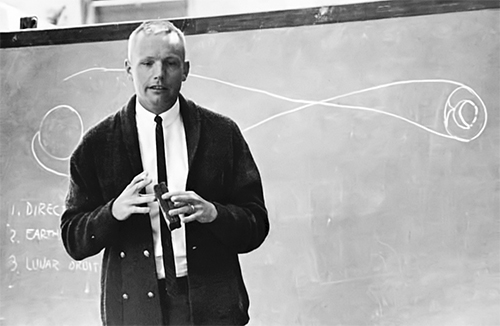

 In the summer of 1969 I was back in West Virginia directing the NYSC's natural sciences program and on the final day of camp traveled to Charleston WV with delegates and other staph
In the summer of 1969 I was back in West Virginia directing the NYSC's natural sciences program and on the final day of camp traveled to Charleston WV with delegates and other staph 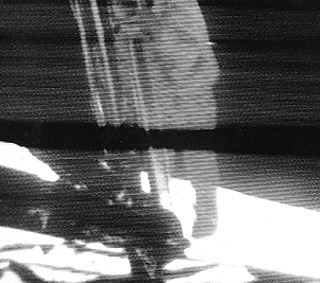 Tears came to my eyes and a prideful lump filled my craw when I saw him make his first small footprint in dust that had never known a human's touch.
Tears came to my eyes and a prideful lump filled my craw when I saw him make his first small footprint in dust that had never known a human's touch.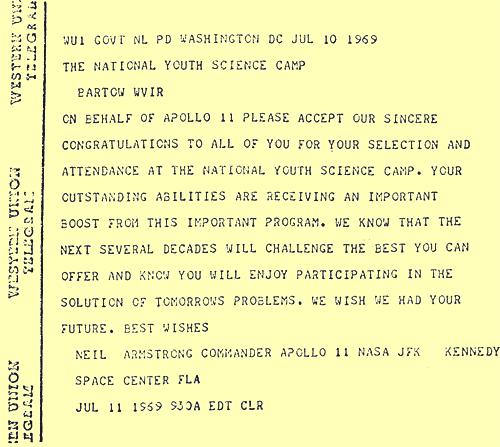
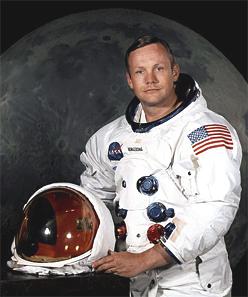



 Please report your sightings of
Please report your sightings of